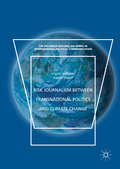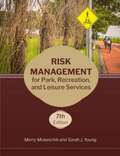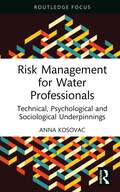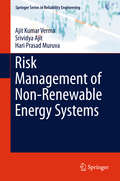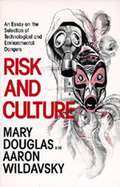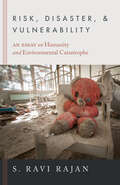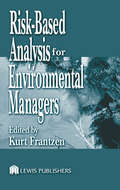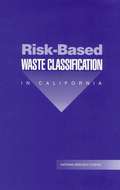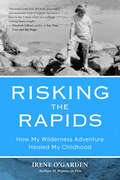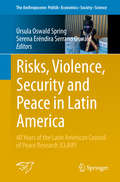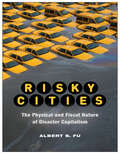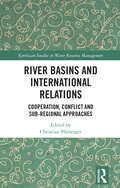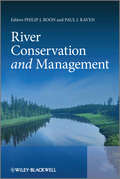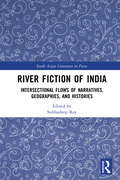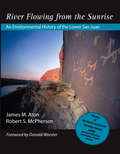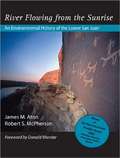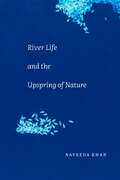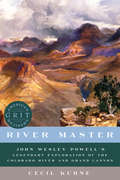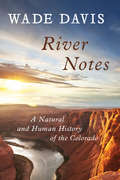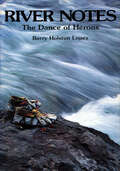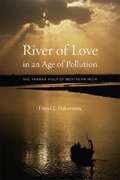- Table View
- List View
Risk Journalism between Transnational Politics and Climate Change (The\palgrave Macmillan Series In International Political Communication Ser.)
by Ingrid Volkmer Kasim SharifThis book introduces a new methodology to assess the way in which journalists today operate within a new sphere of communicative ‘public’ interdependence across global digital communities by focusing on climate change debates. The authors propose a framework of ‘cosmopolitan loops,’ which addresses three major transformations in journalistic practice: the availability of ‘fluid’ webs of data which situate journalistic practice in a transnational arena; the increased involvement of journalists from developing countries in a transnationally interdependent sphere; and the increased awareness of a larger interconnected globalized ‘risk’ dimension of even local issues which shapes a new sphere of news ‘horizons.’ The authors draw on interviews with journalists to demonstrate that the construction of climate change ‘issues’ is increasingly situated in an emerging dimension of journalistic interconnectivity with climate actors across local, global and digital arenas and through physical and digital spaces of flows.
Risk Management for Park, Recreation, and Leisure Services
by Merry Moiseichik Sarah J. YoungRisk Management for Park, Recreation, and Leisure Services provides park, recreation, and leisure services professionals a primer in risk management, tort liability, and negligence that gives them an awareness of legal liability and allows them to take the lead in managing risk within their organizations. It covers topics from the emergency action plan, to the risk management plan, to managing employees through the lens of minimizing risk, to addressing risk at events and in facilities. <p><p>This book provides recreation professionals with the necessary knowledge to build, implement, and manage a risk management plan that first and foremost offers participants a quality experience in a safe environment and, second, protects the professionals and their employees from undue risk.
Risk Management for Water Professionals: Technical, Psychological and Sociological Underpinnings (Routledge Focus on Environment and Sustainability)
by Anna KosovacThis book presents a comprehensive view of the different theories of risk management in water, drawing on recent studies that serve to inform the way that practitioners consider their own risk practice.While it is commonplace to see risk described in technical and engineering terms when discussing water, this book argues that this is a flawed practice that results in poor decision-making, particularly where water intersects with social elements and the community. Challenging these traditionally held notions of risk, this book introduces the psychological and sociological underpinnings to water risk decisions. Using these, it argues for a broader view of risk-based thinking and proposes a number of evidence-based actions for policymakers to directly implement. Drawing on primary research conducted with water professionals across a variety of roles, this book highlights how the effect of psychological inputs, such as dread and reputation, can create barriers to implementing novel water solutions or projects. Through understanding the biases covered in this book, water practitioners can work to support processes that seek to encourage new and innovative methods in water management.This book will be of great interest to professionals working in water management, including those in government roles, planning departments and consultancies. It is also a great reference for students of both water resource management and risk studies more generally.
Risk Management of Non-Renewable Energy Systems
by Srividya Ajit Ajit Kumar Verma Hari Prasad MuruvaThis book describes the basic concepts of risk and reliability with detailed descriptions of the different levels of probabilistic safety assessment of nuclear power plants (both internal and external). The book also maximizes readers insights into time dependent risk analysis through several case studies, whilst risk management with respect to non renewable energy sources is also explained. With several advanced reactors utilizing the concept of passive systems, the reliability estimation of these systems are explained in detail with the book providing a reliability estimation of components through mechanistic model approach. This book is useful for advanced undergraduate and post graduate students in nuclear engineering, aerospace engineering, industrial engineering, reliability and safety engineering, systems engineering and applied probability and statistics. This book is also suitable for one-semester graduate courses on risk management of non renewable energy systems in all conventional engineering branches like civil, mechanical, chemical, electrical and electronics as well as computer science. It will also be a valuable reference for practicing engineers, managers and researchers involved in reliability and safety activities of complex engineering systems.
Risk and Culture: An Essay on the Selection of Technological and Environmental Dangers
by Aaron B. Wildavsky Mary DouglasThis research-based book speaks about risks of lapses on environmental conservation and protection endangering the life and security of Americans and the imperative need to wake up and address the issues.
Risk and Responsibilisation in Public Communication: The Global Challenges of COVID-19 and Climate Change (Earthscan Risk in Society)
by Antoinette Fage-ButlerThis book explores the connections between risk and responsibilisation in official communication to the public about the global risks of the pandemic and climate change. Our media spheres in the 2020s have been saturated with information about what we should or should not be doing to meet the challenges of the COVID-19 pandemic and climate change. Although the ability of risk communication to ‘responsibilise’ the public is central to its functioning in our societies, this aspect has so far been under-investigated in academia. To address this lacuna, Antoinette Fage-Butler develops a discursive approach to risk communication that focuses on the values that are communicated in risk messages. Examples of official risk communication about the pandemic and climate change from national and transnational contexts are analysed and compared, leading to new empirical findings and theoretical insights about the nature of risk and responsibilisation. Fage-Butler also builds on recent stirrings in the evolving field of risk communication that highlight the importance of cultural and value-related factors. Overall, this book will equip researchers with an approach to risk communication that reflects the complexity of today’s global risk challenges. Risk and Responsibilisation in Public Communication will be of great interest to students and scholars of risk communication, public health and environmental studies.
Risk, Disaster, and Vulnerability: An Essay on Humanity and Environmental Catastrophe
by S. Ravi RajanOver the course of the past century, there has been a sustained reflective engagement about environmental risks, disasters, and human vulnerability in our modern industrial world. This inquiry has raised a host of crucial questions. Just how safe is humanity in a world of toxic chemicals and industrial installations that have destructive potential? Is it feasible to prevent large-scale catastrophes like the ones in Bhopal, Chernobyl, and Fukushima and smaller-scale disasters such as oil spills and gas leaks? How do environmental hazards affect social and political orders? S. Ravi Rajan expertly synthesizes decades of public policy and academic discourse on how societies measure and ultimately come to terms with risk, danger, and vulnerability and offers a fresh, humanistic perspective for grappling with the new global scale and interconnectedness of these threats.
Risk-Based Analysis for Environmental Managers
by Kurt A. FrantzenAll corporations must perform evaluations to define the risks to public health and the environment. Your corporation can get the edge by evaluating risk with a process that begins with the "end-in-mind" for the property and that concludes with a cogently communicated argument that addresses the issues. With this in mind, Risk-Based Analysis for Env
Risk-Based Waste Classification in California
by Committee on Risk-Based Criteria for Non-RCRA Hazardous WasteThe National Academies Press (NAP)--publisher for the National Academies--publishes more than 200 books a year offering the most authoritative views, definitive information, and groundbreaking recommendations on a wide range of topics in science, engineering, and health. Our books are unique in that they are authored by the nation's leading experts in every scientific field.
Risking the Rapids: How My Wilderness Adventure Healed My Childhood
by Irene O'GardenA memoir of a dysfunctional, grieving family reuniting for a turbulent rafting trip, from an author with a “captivating talent for wonder and marvel.”?Elizabeth Gilbert, author of Eat, Pray, LoveAfter the sudden death of Irene O’Garden’s older brother, she and her family decide to seek closure together by taking a journey through the remotest spot in Montana. The story of their harrowing trip on the river is intertwined here with the author’s account of growing up with her six siblings in a clashing Catholic family under the shadow of alcoholism.O’Garden’s father, a local TV personality in Minnesota, leaves his cheery public persona behind when he comes home and starts drinking martinis with his undemonstrative, icy-hearted wife. The children vary in their responses to profound anxiety sown in an atmosphere of neglect, psychological abuse, and rigid religiosity: One brother bites his fingers to gangrene. One relentlessly bullies the author, who begins overeating compulsively. One severs all ties with the family. Meanwhile, in the present, danger mounts as well on the raft trip, when unusual river conditions swell and speed the waters. Both stories build with escalating intensity to excruciating climaxes.Some memoirs shock. Some entertain. Some take us places we’re afraid to go. A rare few move us. Once in a blue moon, a book does it all. This is Risking the Rapids.“Enthralling.” —Malachy McCourt, author of A Monk Swimming“A deep and powerful memoir.” —Martha Beck, author of Finding Your Own North Star“Breathtaking . . . O’Garden adds a thoroughly welcome voice to the rich vein of American literature on the singular healing powers of wilderness.”? Florence Williams, award-winning author of The Nature Fix
Risks, Violence, Security and Peace in Latin America: 40 Years of the Latin American Council of Peace Research (CLAIP) (The Anthropocene: Politik—Economics—Society—Science #24)
by Úrsula Oswald Spring Serena Eréndira Serrano OswaldThis book analyses the war against drugs, violence in streets, schools and families, and mining conflicts in Latin America. It examines the nonviolent negotiations, human rights, peacebuilding and education, explores security in cyberspace and proposes to overcome xenophobia, white supremacy, sexism, and homophobia, where social inequality increases injustice and violence. During the past 40 years of the Latin American Council for Peace Research (CLAIP) regional conditions have worsened. Environmental justice was crucial in the recent peace process in Colombia, but also in other countries, where indigenous people are losing their livelihood and identity. Since the end of the cold war, capitalism aggravated the life conditions of poor people. The neoliberal dismantling of the State reduced their rights and wellbeing in favour of enterprises. Youth are not only the most exposed to violence, but represent also the future for a different management of human relations and nature.
Risky Cities: The Physical and Fiscal Nature of Disaster Capitalism (Nature, Society, and Culture)
by Albert S. FuOver half the world’s population lives in urban regions, and increasingly disasters are of great concern to city dwellers, policymakers, and builders. However, disaster risk is also of great interest to corporations, financiers, and investors. Risky Cities is a critical examination of global urban development, capitalism, and its relationship with environmental hazards. It is about how cities live and profit from the threat of sinkholes, garbage, and fire. Risky Cities is not simply about post-catastrophe profiteering. This book focuses on the way in which disaster capitalism has figured out ways to commodify environmental bads and manage risks. Notably, capitalist city-building results in the physical transformation of nature. This necessitates risk management strategies –such as insurance, environmental assessments, and technocratic mitigation plans. As such capitalists redistribute risk relying on short-term fixes to disaster risk rather than address long-term vulnerabilities.
Risky Futures: Climate, Geopolitics and Local Realities in the Uncertain Circumpolar North (Studies in the Circumpolar North #6)
by Olga Ulturgasheva Barbara BodenhornThe volume examines complex intersections of environmental conditions, geopolitical tensions and local innovative reactions characterising ‘the Arctic’ in the early twenty-first century. What happens in the region (such as permafrost thaw or methane release) not only sweeps rapidly through local ecosystems but also has profound global implications. Bringing together a unique combination of authors who are local practitioners, indigenous scholars and international researchers, the book provides nuanced views of the social consequences of climate change and environmental risks across human and non-human realms.
Rites of Love (The Ringing Cedars Series #8, Part #2)
by Vladimir Megré John Woodsworth Leonid SharashkinThis book is a call to research, to becoming aware of the Divine programme.
River
by Debby AtwellWith direct language and colorful paintings, Debby Atwell relates the changes that occur through the centuries along a riverbank, from the arrival of the first humans to the coming of the first settlers, from the industrial revolution to the present day. As the river flows the country grows and progresses along its banks-sometimes for better and sometimes for worse. When overuse and carelessness finally take their toll, the river's natural beauty and resources are compromised. Can the river thrive permeated by pollution and waste? Travel downstream through time as Atwell's evocative text and narrative paintings enliven the beauty and spirit of the river, revealing life as it was and telling how it has evolved.
River Basins and International Relations: Cooperation, Conflict and Sub-Regional Approaches (Earthscan Studies in Water Resource Management)
by Christian PlobergerThis book argues that river basins represent a particular structural setting in international relations with the potential for generating a dynamic of cooperation among the involved countries. The volume applies the concept of regional cooperation to international river basins to highlight their relevance as a particular space in international relations, emphasizing both the inter-connectivity and transnationalism of international river basins. It addresses the challenges related to resource distribution between up- and down-stream countries, showcasing a variety of examples of cooperation and conflictual relations within various international river basins. Case studies are drawn from across the globe and include the Mekong, the Indus, the Euphrates-Tigris and the Danube international river basins. Each chapter outlines the different aspects which support or undermine cooperation in each case, taking into consideration key areas surrounding resource sharing, national development, environmental considerations and national security. This book will be of great interest to students and scholars with an interest in international river basins, regional cooperation, water resource competition, international relations and environmental politics.
River Conservation and Management
by Paul Raven Philip BoonThis book is intended for those with an academic, scientific and practical interest in river conservation and management. It provides an overview of how changes in legislation, policies, institutional responsibilities, science, technology, practical techniques and public perception have influenced how rivers have been managed over the past 20 years and the challenges that lie ahead during the next 20 years.The book is based on the international conference River Conservation and Management:20 Years On held at York. Thirty-one chapters, with contributions from North and South America, Europe, Asia and Australasia provide a wide-ranging perspective on this complex but profoundly important subject. Following an introduction that chronicles the most important contextual changes, the book is organized into four broad topics:Catchment management, ecosystem integrity and the threats to river ecosystems - this covers progress on understanding and addressing the pressures affecting rivers, many of which will be amplified by climate change and increasing human demands for water; Methods and approaches - illustrating some recent techniques that have been developed to assess condition and conservation status across different types of river; Recovery and rehabilitation - providing an insight into the principles, practice, public involvement and institutional networks that support and make improvements to modified river reaches; Integrating nature conservation into wider river management -demonstrating the importance of integrated planning, involvement of local communities and the use of adaptive management in achieving multiple environmental and economic benefits along rivers used for different purposes. The final chapter discusses the challenges faced in dealing with an uncertain future.More than 1200 different references and numerous web-site citations provide the reader with an invaluable source of knowledge on the subject area.
River Fiction of India: Intersectional Flows of Narratives, Geographies, and Histories (South Asian Literature in Focus)
by Subhadeep RayThis book establishes river fiction as an identifiable genre-fiction. It argues that rivers and riverbeds—through myths and legends, ecological and environmental concerns, geographical and historical realities, politics and economics around them—can provide an underlying framework to understand Indian prose fiction. With essays on river fiction across India, the volume presents a new way of understanding and reading South Asian literature. The volume will be of great interest to scholars and researchers of literature and literary criticism and South Asian studies.
River Flowing From The Sunrise: An Environmental History of the Lower San Juan
by James M Aton Robert McPhersonThe authors recount twelve millennia of history along the lower San Juan River, much of it the story of mostly unsuccessful human attempts to make a living from the river's arid and fickle environment. From the Anasazi to government dam builders, from Navajo to Mormon herders and farmers, from scientific explorers to busted miners, the San Juan has attracted more attention and fueled more hopes than such a remote, unpromising, and muddy stream would seem to merit.
River Flowing from the Sunrise
by Robert S. Mcpherson James M. AtonThe authors recount twelve millennia of history along the lower San Juan River, much of it the story of mostly unsuccessful human attempts to make a living from the river's arid and fickle environment. From the Anasazi to government dam builders, from Navajo to Mormon herders and farmers, from scientific explorers to busted miners, the San Juan has attracted more attention and fuelled more hopes than such a remote, unpromising, and muddy stream would seem to merit.
River Life and the Upspring of Nature
by Naveeda KhanIn River Life and the Upspring of Nature Naveeda Khan examines the relationship between nature and culture through the study of the everyday existence of chauras, the people who live on the chars (sandbars) within the Jamuna River in Bangladesh. Nature is a primary force at play within this existence as chauras live itinerantly and in flux with the ever-changing river flows; where land is here today and gone tomorrow, the quality of life itself is intertwined with this mutability. Given this centrality of nature to chaura life, Khan contends that we must think of nature not simply as the physical landscape and the plants and animals that live within it but as that which exists within the social and at the level of cognition, the unconscious, intuition, memory, embodiment, and symbolization. By showing how the alluvial flood plains configure chaura life, Khan shows how nature can both give rise to and inhabit social, political, and spiritual forms of life.
River Master: John Wesley Powell's Legendary Exploration Of The Colorado River And Grand Canyon (American Grit #0)
by Cecil KuhneExperience John Powel's now-famous expedition through the Grand Canyon In 1869, Civil War veteran and amputee Major John Wesley Powell led an expedition down the uncharted Colorado River through the then-nameless Grand Canyon. This is the story of what started as a geological survey, but ended in danger, chaos, and blood. The men were inexperienced and ill-equipped, and they faced unimaginable peril. Along the way there was death, mutiny, and abject terror, but Powell persevered and produced a masterwork of adventure writing still held in the highest regard by the boatmen who follow his course today. With never-before-used primary sources and firsthand experience navigating Powell’s legendary route, Cecil Kuhne brings this remarkable chapter of frontier history to life. The American Grit series brings you true tales of endurance, survival, and ingenuity from the annals of American history. These books focus on the trials of remarkable individuals with an emphasis on rich primary source material and artwork.
River Notes: A Natural and Human History of the Colorado
by Wade DavisPlugged by no fewer than twenty-five dams, the Colorado is the world's most regulated river drainage. The Colorado River provides most of the water supply of Las Vegas, Tucson, and San Diego, and much of the power and water of Los Angeles and Phoenix, cities that are home to more than 25 million people. If it ceased flowing, the water held in its reservoirs might hold out for three to four years, but after that it would be necessary to abandon most of southern California and Arizona, and much of Colorado, New Mexico, Utah and Wyoming. For the entire American Southwest the Colorado is indeed the river of life, which makes it all the more tragic and ironic that by the time it approaches its final destination, it has been reduced to a shadow upon the sand, its delta dry and deserted, its flow a toxic trickle seeping into the sea. In this remarkable blend of history, science, and personal observation, acclaimed author Wade Davis tells the story of America's Nile, how it once flowed freely and how human intervention has left it near exhaustion, altering the water temperature, volume, local species, and shoreline of the river Theodore Roosevelt once urged us to "leave it as it is." Yet despite a century of human interference, Davis writes, the splendor of the Colorado lives on in the river's remaining wild rapids, quiet pools, and sweeping canyons. The story of the Colorado River is the human quest for progress and its inevitable if unintended effects--and an opportunity to learn from past mistakes and foster the rebirth of America's most iconic waterway. A beautifully told story of historical adventure and natural beauty, River Notes is a fascinating journey down the river and through mankind's complicated and destructive relationship with one of its greatest natural resources.
River Notes: The Dance of Herons
by Barry Holstun LopezAn acclaimed nature writer evokes and celebrates the forces, settings, rituals, movements, and imperatives of a river, as it calls us back to unity with the natural world.
River Of Love In An Age Of Pollution: The Yamuna River Of Northern India
by David L. HabermanCelebrated as an aquatic form of divinity for thousands of years, the Yamuna is one of India's most sacred rivers. A prominent feature of north Indian culture, the Yamuna is conceptualized as a goddess flowing with liquid love -- yet today it is severely polluted, the victim of fast-paced industrial development. <P> This fascinating and beautifully written book investigates the stories, theology, and religious practices connected with this river goddess collected from texts written over several millennia, as well as from talks with pilgrims, priests, and worshippers who frequent the pilgrimage sites and temples located on her banks. <P> David L. Haberman offers a detailed analysis of the environmental condition of the river and examines how religious practices are affected by its current pollution. He introduces Indian river environmentalism, a form of activism that is different in many ways from its western counterpart. River of Love in an Age of Pollution concludes with a consideration of the broader implications of the Yamuna's plight and its effect on worldwide efforts to preserve our environment.
